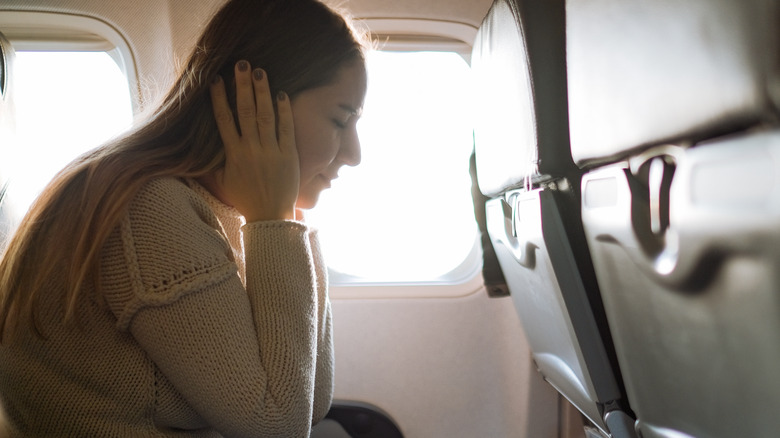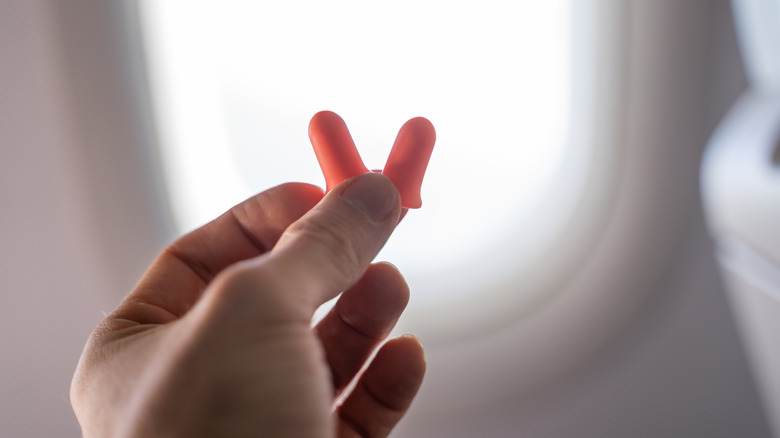Why You Should Think Twice Before Chewing Gum On Your Next Flight
We may receive a commission on purchases made from links.
When preparing for air travel, passengers often pack items intended to provide comfort during the flight. Noise-cancelling headphones? Check. Cushy neck pillow? Check. In-flight entertainment? Check. Gum? Check. Indeed, chewing gum is a popular "must-have" for takeoff and landing, believed to relieve ear pressure by encouraging saliva production and swallowing, thereby opening the ear's Eustachian tube. However, this seemingly harmless treat can have unintended consequences, particularly concerning digestive discomfort.
Chewing gum, when done vigorously or for an extended period, leads to swallowing excess air into the stomach instead of the lungs, a condition known as aerophagia. In the confined space of an airplane, where movements are restricted, this can lead to significant unease. The swallowed air accumulates in the digestive tract, causing bloating and abdominal pain. This can be particularly problematic on long-haul flights where the opportunity for movement and relief is limited (and we all know the bathroom lines can get especially long after meals).
Sugar-free gums contain artificial sweeteners like sorbitol, xylitol, and mannitol. While these sweeteners reduce the calorie content, they are not fully absorbed by the body and can even act as laxatives when consumed excessively. The result can be an unpleasant combo of diarrhea, cramping, and stomach pain, especially for people with sensitive digestive systems. Moreover, chewing gum tricks the body into preparing for food digestion, activating the release of digestive acids and enzymes. However, when no food follows, this can lead to an imbalance in the stomach, potentially causing acid reflux.
Alternatives to chewing gum
Although chewing gum is a convenient, affordable, and tasty solution, there are better options. When considering substitutes for chewing gum, it's essential to explore alternatives that are both effective against airplane ear (barotrauma) and gentle on your body. Sucking on hard candy is a great replacement for gum. The act of sucking stimulates saliva production and encourages swallowing, which restores ear pressure balance without exacerbating potential aerophagia.
Engaging in yawning and swallowing movements can be another effortless way to equalize ear pressure, especially during takeoff and landing when pressure changes are most noticeable. Staying hydrated with regular sips of water is not only good for overall health but can also clear up blocked ears. Gentle stretches and movements of the neck and jaw can aid in relieving tension and promoting ear pressure equalization.
The Valsalva Maneuver, which involves gently exhaling while keeping the nose pinched and mouth closed, and the genius balloon hack can also help unclog your ears during and post-flight. Over-the-counter nasal sprays can clear the Eustachian tubes and are especially useful for those who experience congestion and suffer from the notoriously dry airplane air. Taking an anti-inflammatory 30 minutes before a flight to reduce pressure in the sinuses is another worthwhile remedy.
Investing in a pair of filtered pressure-regulating earplugs, such as Alpine FlyFit or Mack's Flightguard, can be a game changer. These specialized earplugs are designed to reduce the agonizing ear pain caused by changes in cabin pressure while also blocking out unpleasant in-flight noises.

